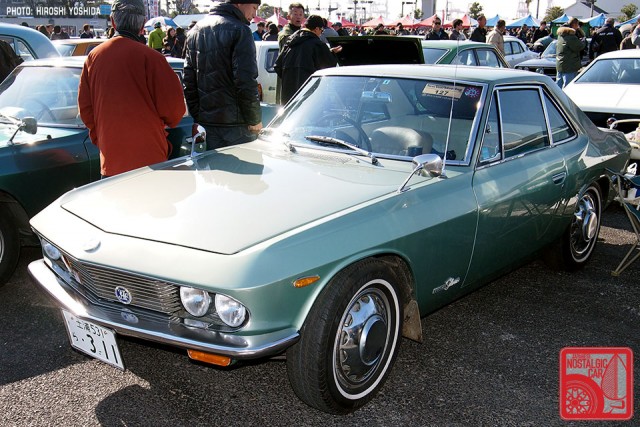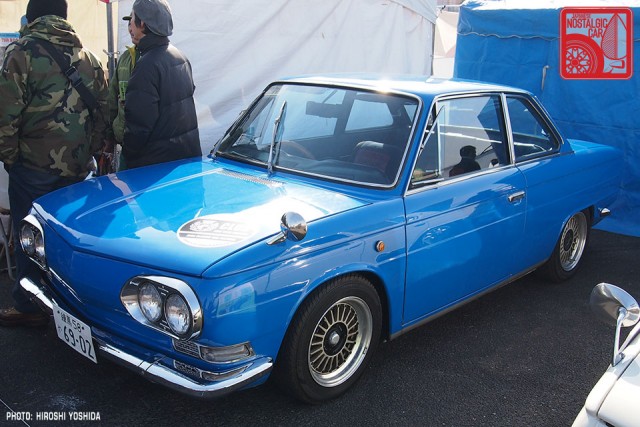
The Japanese Classic Car Association is one of the nation’s largest organizations for old car enthusiasts. Each year, the New Year Meeting show draws thousands. This year’s event took place on Sunday, January 26 from 9-4 in the Aomi Parking Area in Odaiba, Tokyo. In Part 01, we’ll look at the Sixties Sports that kickstarted Japan’s fascination for enthusiast automobiles.


In the 1960s, Japan was just emerging from the rubble of World War II. The majority of the country was still driving around in kei cars, but automakers aspired to go beyond utilitarian runabouts. Because most automakers had only a handful of models in their portfolios, enthusiast-oriented models were often simply distinguished by the addition of the word “sports” in their name, as is the case with Toyota‘s first sports car, the aptly named Sport 800.
It was powered by a two-cylinder boxer, a trait Toyota would invoke years later when referencing the boxer at the heart of its GT86 (aka Scion FR-S), built in conjunction with Subaru.
Many of the Japanese performance cars that we revere today got their start in during this era. Soichiro Honda’s first passenger car was the Honda S-Series (again, S stood for “sports”), offered as the S500, S600 and S800 depending on displacement in cubic centimeters. Years later, Honda would resurrect the moniker for use on the S2000 and soon-to-arrive S660.

However, construction methods had not yet achieved the efficiency of today’s Japan, Inc. factories. Many of these early sports cars were hand-built in extremely limited numbers. The 1965-68 CSP311 Silvia is the great,-great-great-grandfather of all the 240SXes on the drift circuit today. Three of the 554 built appeared at the show.


The car it’s based on, the SP311 Datsun Fairlady Sports, was the first true performance Fairlady, a name still used on Japanese versions of the Nissan Z. Again, appending the word “Sports” onto the model name seemed to convey everything you needed to know about it.
The Mazda Cosmo Sport, named the 110S in export versions, was Mazda’s first sports car and also its first stab at a dual-rotor Wankel, the first “mass-produced” engine of its kind in the world. Of course, in this case “mass-produced” means just 1,519 examples. Thanks to a record price at Monterey last year, prices have shot through the roof, to the point where even an utter basketcase is breaking six figures.

To make the rotary engine more attainable by the masses, Mazda then plopped it into the R100, another exceedingly rare car these days that will probably soon follow the Cosmo Sport in price. Though this 1970 Mazda Familia Rotary Coupe wears UK-made Cosmic wheels, they were de rigueur in Seventies Japan.
From its birth in 1968 until 1973, Isuzu‘s beautiful 117 Coupe was also hand-built. After partnering with GM, Isuzu was obligated to convert the 117 into a mass production model, which was sold until 1981. Before the assembly-line version, 2,458 hand-built examples were created, making them the most desirable and collectable ones.

A car that rarely receives any attention stateside but is a standard in any Japanese classic list is the Hino Contessa. Rear-engined and cooled both from the rear and by water, its grille-less mask sits atop a rather unusual branch of the automotive kingdom. Hino is purely a maker of commercial trucks today, but in the Sixties the Contessa was its crown jewel.



Before GM’s involvement, Isuzu was on fire. The 117 Coupe took care of the large luxury coupe end of the lineup, while the compact Bellett satisfied enthusiasts. In particular, the black-hooded, black-striped Bellett GT-R was a race version ahead of its time, dating almost as early as the Nissan Skyline in both use of a twin-cam motor (albeit an inline-four) the GT-R name. Though many run-of-the-mill Belletts were built, only about 1,400 GT-Rs were made.
To be continued…















New Year Meeting…I always forget it is closer to the end of January.
(Great coverage Hiroshi. Looking forward to part two).
Toyota S800 engine was four stroke, not two stroke.
And what’s all this nonsense about the Bellett GT-R predating the ‘Skyline’ in the use of a DOHC engine and in using the ‘GT-R’ moniker? PGC10 Skyline GT-R debuted in February 1969, whilst the Bellett 1600 GTR debuted in September 1969.
The Isuzu that trumped the Nissan in terms of production DOHC engines was the 117 (October 1968) not the Bellett, and if you want to look at Honda and Toyota you can see examples that trump both.
Big point about the S20 was that it was four-valve, not just two.
Noted on all counts, thanks Alan.
“Before GM’s involvement, Isuzu was on fire.” – Yup, Isuzu’s fate is so very depressing. 🙁
Awesome pics.
Nice work, Hiroshiさん。
Can you make the images so we can see them full size? (the Datsun/Nissan images won’t enlarge!)
Thanks– spriso
Looks like much better weather than last years event at Fuji Speedway. My trip to the show would have been made so much easier had it been in it’s usual spot of Odaiba, but the adventure of getting to the Speedway and back in the pouring rain made it all the more fun looking back on it!
What kind of wheels are on that green Bellett on the bottom of the page?